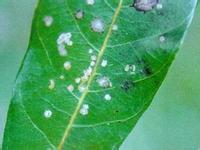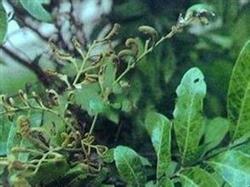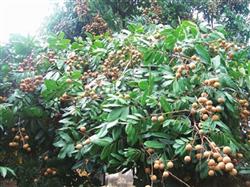Pest control of litchi and longan in autumn and winter

First, the species and control of insect pests in autumn shoot. Autumn shoots are the fruiting branches of next year, if eaten by pests, it will seriously affect the formation of flower buds next year. Autumn shoot pests are mainly a variety of leaf-eating inchworms and leaf rollers. Among them, gall mites (felt disease) and longan horncheek wood lice are the most serious from September to November every year. Therefore, during this period of time, the orchard should be inspected frequently, especially when the tender shoots are just drawn out until the leaves turn red. To control this kind of pests, you can spray "Shechongbao" EC with water 1500 times, and a bottle of medicine with a capacity of half a kilogram can dilute 350kg of water. It can also use 1500 times of water, such as high-efficiency Baike EC and Shulaiding EC, etc., and the effect is also good. Second, the control of insect pests in winter. 1. Tortoise-backed longicorn beetles: the damage to some 30-year-old litchi and longan trees is very serious, many branches wither and die, and a generation of longicorn beetles occur every year. The adults are feathered in July and lay eggs on the big branches of the mother finger in August. In September, a large number of eggs began to hatch into first-instar larvae, and a few turned to second-instar larvae in December. From October to December, it is the most ideal time for drug control of juvenile insects, which can be controlled by chemical control or manual capture. 2. Leaf gall mosquito: at present, the damage is very serious in various places. the insect begins to invade the young leaves and destroys the whole leaves when the leaves turn green, which greatly affects the photosynthesis of the leaves, weakens the growth of the whole tree and has a great impact on the yield. Because the leaf gall midge has 7 generations in the whole year, and the generations are overlapped, when the young leaves are slightly larger than the rice grains, the adults can lay eggs on the leaves and can invade people until the leaves do not turn green. In recent years, according to the living habits of leaf gall midge, when overwintering mature larvae crawl in and out of the soil from the leaf gall to pupate, around the tree crown, we use 3% isosalidophos granule, 5 kg per mu, add 20 kg fine sand or mud sand to mix evenly from the end of February to early March every year, sprinkle the medicine evenly in the soil around the crown, and cover 1cm soil thinly. The drug can maintain its efficacy for 30-40 days under the condition of soil covering. It can touch the drug and die when the larvae are in the soil and when the adults are unearthed from the end of March to April. This method has been applied to nearly 10,000 50-year-old litchi in Yuanshanbei and Qingxi Town, Dongwu City, and the control effect is more than 93.78%. The drug is used only once a year, and the annual effect can be achieved. 3. Leaf mite (felt disease): spray triclofenac 800 times when the tender shoot grows slightly in autumn, spray 1 Mel twice. The ancestors of spider mites invaded tender leaves, such as controlling winter shoots, spraying shoot-promoting hormone in time, and killing winter shoots, which can reduce the occurrence of spider mites. Third, the control of litchi diseases in winter. Litchi downy blight pathogen overwinters in diseased leaves, diseased branches, fallen leaves, withered branches and soil around trees. The elimination of overwintering pathogens can reduce the outbreak of the disease in early spring. In the first and middle of March every year, before the litchi blossoms, spray the canopy branches and leaves, under the tree and the surrounding ground soil comprehensively with copper oxychloride 500 murine 600 times, or 0.5% lime equivalent Bordeaux liquid, to kill the pathogen. Winter prevention should be carried out in all places where the historical frost epidemic is serious. Litchi anthracnose often occurs in weak trees. Spraying with 80% spray powder 600-8OO or methyl topiramate 8OO plus 1% urea can effectively prevent the occurrence of anthracnose. Fourth, heavy application of organic fertilizer to improve the soil, so that litchi heading, flowering and fruiting, can have enough fertilizer to supply tree nutrition. Apply basic fertilizer, such as chicken manure, pig manure, human feces and urine, garbage, green manure, etc., each tree bearing 50 kg fruit, dig a ring-shaped trench around the dripping line around the crown, apply fertilizer, chicken manure, pig manure, mature waste fertilizer, each tree applies 25tel 40kg; if human feces and urine, peanut bran water fertilizer is applied, 100kg green fertilizer is applied, plus 0.5kg 1.0kg superphosphate, 0.5 kg lime. However, organic fertilizer can not be applied no later than the middle of November at the latest, too late will cause adverse effects. In order to increase the yield of litchi and longan continuously, the habit of applying only chemical fertilizer should be changed, which plays an important role in increasing the yield of fruit trees.
- Prev

Control techniques of main pests in litchi and longan
There are more than 50 kinds of pests found in litchi and longan, among which there are 5 kinds of litchi bugs, litchi stem borer, litchi tip moth, longan wheat moth and dragon eye cheek psyllid. Among them, the first 4 kinds damage litchi and longan at the same time, and the angle cheek psyllid only damages longan. In our province to litchi bug...
- Next

Problems and Countermeasures of out-of-season Longan cultivation
Potassium chlorate was first used to promote flowers in longan in Taiwan, and the out-of-season cultivation of longan in production began in Thailand. In recent years, longan production areas in our province are also trying to use potassium chlorate to promote flower cultivation of out-of-season longan, some of which have achieved certain economic benefits, but most orchards have poor or even no.
Related
- Moge, come on! The staff of the peasant association in the producing area of cantaloupe were frightened when the crowd gathered.
- Causes and Solutions of low Fruit setting rate of Apple
- Symptoms and control measures of passion fruit virus disease
- Fruit growing lesson: how do apple orchards keep high yields?
- Can you build orchards in the mountains? What are the pros and cons?
- How to manage the coloring period of Crisson grape?
- This paper introduces the processing technology of two kinds of fig products.
- How much is a month for retired teachers in rural areas by 2020?
- How can strawberry planting increase sugar content? We should pay attention to management in many aspects.
- What are the cultivation techniques on how to improve the yield of golden fruit?

